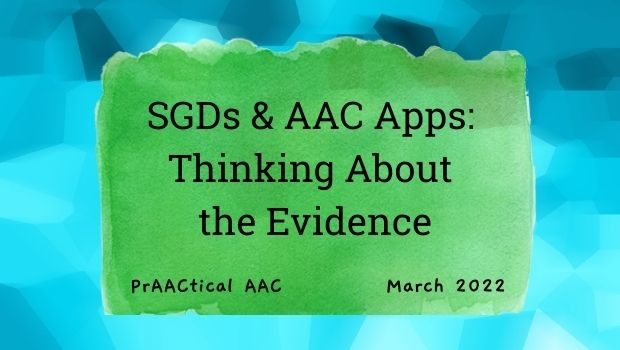SGDs and AAC Apps: Thinking About the Evidence

Professionals who teach people with complex communication needs to express themselves with AAC frequently ask about the evidence base for AAC devices and apps. Evidence-based practice (EBP) has three basic pillars: Clinical expertise, external and internal evidence, and the perspectives of clients and caregivers. We have good evidence for the effectiveness of SGDs and AAC apps as a general category of communication tools, rooted in a strong array of research studies, a great deal of clinical expertise, and extensive experiences of consumers and families. As in many areas of clinical practice, though, more work still needs to be done.
It’s not as easy to get this sort of research evidence as it may seem. A medical device like a speaking valve may have an evidence base tied to a specific brand and model of the equipment because there isn’t a great deal of variability in what it is expected to do or the way that it is used.
An AAC device, on the other hand, has a very large range of settings and configurations even if you are only looking at one specific brand and model. Their versatility is part of what we love about SGDs.
We can take a single SGD and configure it in various ways without a lot of effort. We might set it up for someone with significant intellectual disabilities or very limited motor control on Monday and reconfigure it for someone who is intellectually gifted and athletically talented on Tuesday. We can take that same device and set it up to be appropriate for a toddler in the morning and an adult in the afternoon. There are many aspects of these tools that can be changed, and each one has multiple settings or options.
We can vary the configuration by changing things like:
- What symbols are used;
- How many words are available, what kinds of words those are, and where they are located;
- What access mode is used and the specific settings for that access mode;
- The type of display (e.g., grid, visual scene);
- How vocabulary is arranged (e.g., alphabetically, semantically, by part of speech, by frequency of use);
- How many words, phrases, sentences, and longer utterances are available;
- The role of print/orthography;
- How much navigation is required; and,
- Features that support grammar and faster communication.
The current generation of SGDs offers a more flexible palette of options than we’ve ever had. And that’s a very good thing. But it presents a challenge in terms of research on how effective a specific SGD or AAC app actually is, particularly when you consider external variables. Things like the individual’s characteristics (e.g., age, type of disability, concomitant challenges, exposure to multiple languages) and the support they receive have a substantial bearing on the outcome.
In looking at the evidence base for a particular SGD, we’d either have to have that information for every one of those configurations or look more narrowly and examine the effectiveness of one particular configuration. That can be challenging, given the sheer number of different parameters or variables found in the current generation of SGDs and AAC apps and the extraordinary diversity of those with complex communication needs. Funding for this sort of research is quite limited.
And what about evidence that can help us make comparisons between devices, apps, and specific configurations? Ideally, we’d want research that provides apples-to-apples comparisons to help guide those with complex communication needs and their teams in decision-making. It’s hard to do that when there are so many possible configurations of each device/app, especially when we consider that the technology is constantly evolving.
The flexibility we treasure in today’s AAC devices and apps makes it difficult for investigators to gather the sort of research evidence we’d like to have in guiding teams through the device selection process. We may not have all the research results we’d like to make fair comparisons between pieces of equipment, but we do have two other important aspects of EBP to rely on: Clinical expertise and the perspectives of clients and caregivers.
Additionally, we have a growing body of evidence in the strategies and techniques for supporting people with complex communication needs who are learning to use AAC. Organizations like ISAAC, ASHA, AGOSCI, ATIA, and Communication Matters regularly share this information in journals and newsletters, on websites and social media venues, and at conferences and workshops. In all of these places, we’re excited to see that people with AAC needs are increasingly sharing their knowledge, experiences, priorities, and perspectives so that professionals can learn from the most important stakeholder group of all.
Filed under: Featured Posts, PrAACtical Thinking
This post was written by Carole Zangari

2 Comments
If I ever get through my university degree, I want to do research where I systematically vary the PECS program to see if modifications that bring it more in line with natural language development result in better outcomes.
Thanks for sharing that, Ettina. Systematic modifications are so important in this sort of research. Best of luck!